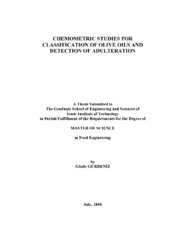Please use this identifier to cite or link to this item:
https://hdl.handle.net/11147/3690Full metadata record
| DC Field | Value | Language |
|---|---|---|
| dc.contributor.advisor | Özen, Banu | - |
| dc.contributor.author | Gürdeniz, Gözde | - |
| dc.date.accessioned | 2014-07-22T13:52:10Z | - |
| dc.date.available | 2014-07-22T13:52:10Z | - |
| dc.date.issued | 2008 | - |
| dc.identifier.uri | http://hdl.handle.net/11147/3690 | - |
| dc.description | Thesis (Master)--Izmir Institute of Technology, Food Engineering, Izmir, 2008 | en_US |
| dc.description | Includes bibliographical references (leaves: 89-94) | en_US |
| dc.description | Text in English; Abstract: Turkish and English | en_US |
| dc.description | xv, 94 leaves | en_US |
| dc.description.abstract | The aim of this study is to classify extra-virgin olive oils according to variety, geographical origin and harvest year and also to detect and quantify olive oil adulteration. In order to classify extra virgin olive oils, principal component analysis was applied on both fatty acid composition and middle infrared spectra. Spectral data was manipulated with a wavelet function prior to principal component analysis. Results revealed more successful classification of oils according geographical origin and variety using fatty acid composition than spectral data. However, each method has quite good ability to differentiate olive oil samples with respect to harvest year.Middle infrared spectra of all olive oil samples were related with fatty acid profile and free fatty acidity using partial least square analysis. Orthogonal signal correction and wavelet compression were applied before partial least square analysis.Correlation coefficient and relative error of prediction for oleic acid (highest amount fatty acid) were determined as 0.93 and 1.38, respectively. Also, partial least square regression resulted in 0.85 as R2 value and 0.085 as standard error of prediction value for free fatty acidity quantification.In adulteration part, spectral data manipulated with principal component and partial least square analysis, to distinguish adulterated and pure olive oil samples, and to quantify level of adulteration, respectively. The detection limit of monovarietal adulteration varied between 5 and 10% and R2 value of partial least square was determined as higher than 0.95. Hazelnut, corn-sunflower binary mixture, cottonseed and rapeseed oils can be detected in olive oil at levels higher than 10%, 5%, 5% and 5%, respectively. | en_US |
| dc.language.iso | en | en_US |
| dc.publisher | Izmir Institute of Technology | en_US |
| dc.rights | info:eu-repo/semantics/openAccess | en_US |
| dc.subject.lcc | TP683 .G97 2008 | en |
| dc.subject.lcsh | Olive oil--Analysis | en |
| dc.subject.lcsh | Chemometrics | en |
| dc.subject.lcsh | Adulterations | en |
| dc.title | Chemometric Studies for Classification of Olive Oils and Detection of Adulteration | en_US |
| dc.type | Master Thesis | en_US |
| dc.institutionauthor | Gürdeniz, Gözde | - |
| dc.department | Thesis (Master)--İzmir Institute of Technology, Food Engineering | en_US |
| dc.relation.publicationcategory | Tez | en_US |
| dc.identifier.wosquality | N/A | - |
| dc.identifier.scopusquality | N/A | - |
| item.openairetype | Master Thesis | - |
| item.cerifentitytype | Publications | - |
| item.grantfulltext | open | - |
| item.fulltext | With Fulltext | - |
| item.openairecristype | http://purl.org/coar/resource_type/c_18cf | - |
| item.languageiso639-1 | en | - |
| Appears in Collections: | Master Degree / Yüksek Lisans Tezleri | |
Files in This Item:
| File | Description | Size | Format | |
|---|---|---|---|---|
| T000707.pdf | MasterThesis | 1.11 MB | Adobe PDF |  View/Open |
CORE Recommender
Page view(s)
276
checked on Apr 7, 2025
Download(s)
4,890
checked on Apr 7, 2025
Google ScholarTM
Check
Items in GCRIS Repository are protected by copyright, with all rights reserved, unless otherwise indicated.